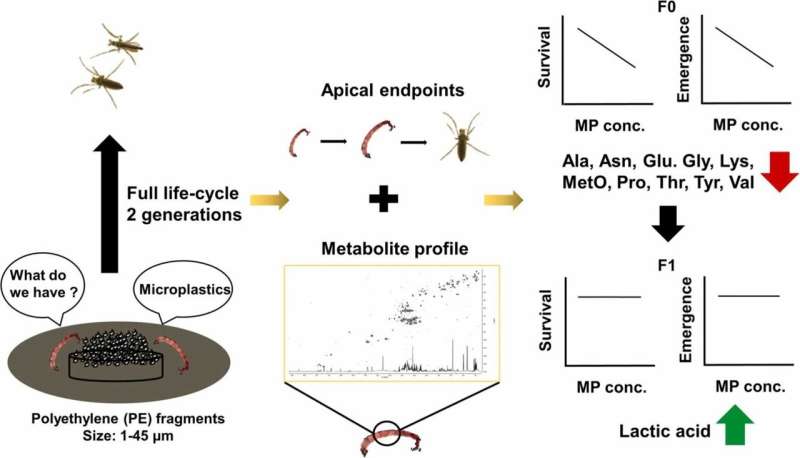This article has been reviewed according to Science X's editorial process and policies. Editors have highlighted the following attributes while ensuring the content's credibility:
fact-checked
peer-reviewed publication
trusted source
proofread
Microplastics ingestion under the microscope in invertebrates

A study led by Griffith University researchers has exposed two generations of a sediment-dwelling invertebrate to microplastic and found that while the 'parent' generation experienced negative impacts, the 'child' generation did not, possibly suggesting a potential adaptation response.
The study, led by Ph.D. candidate Hsuan-Cheng Lu and the team from the ARI Toxicology Research Program in Griffith's Australian Rivers Institute in collaboration with CSIRO, is the first metabolomics assessment in freshwater macroinvertebrate Chironomus tepperi to microplastic exposure.
The research, "Metabolomic responses in freshwater benthic invertebrate, Chironomus tepperi, exposed to polyethylene microplastics: A two-generational investigation," has been published in the Journal of Hazardous Materials.
The results showed significant negative impacts on survival, growth, and emergence of C. tepperi in the parental generation, but no such adverse effects were observed in the subsequent generation.
Metabolite profiles in parental generation indicated that ingestion of microplastics could have influence on bioenergetics through inhibition of food acquisition or nutrient assimilation, which subsequently affect the survival, growth and emergence of parental larvae.
Larvae in unexposed conditions showed no differences in survival or metabolite profiles, suggesting that effects in the parental generation did not carry over to the next generation.
"The results of the study suggest that Chironomus larvae have the potential to adapt within a generation to environmental stressors, such as low levels of microplastics in sediment," Lu said.
As contaminants of emerging concern, microplastics have been widely reported in global freshwater environments and freshwater sediment is considered as a major sink.
Despite ingestion of microplastics being well documented in aquatic organisms, there is limited information on effects of microplastics on the freshwater sediment-dwelling—or benthic—invertebrates, especially at realistic environmental concentrations and across generations.
This study provides insight into the lethal effects of microplastics on C. tepperi over two generations. Additionally, this study provides the first evaluation of metabolomics profiling to unravel the potential organismal and physiological responses of microplastics ingestion in C. tepperi.
"While the findings of the present study suggest that Chironomus larvae can adapt to low levels of microplastics, the mechanism is unclear," Lu said.
"Do they learn not to ingest it? Is there a physiological adaptive mechanism? What happens in longer exposures? Do we see this adaptation continue in the third and further generation, or is it lost?
"Also, our experiment was done with low levels of microplastics, but microplastics contamination is expected to increase as our use of plastics continues to increase, so what would higher levels of microplastics do?
"Future research should also be conducted to assess the energy uptake and allocation in response to MP exposure."
More information: Hsuan-Cheng Lu et al, Metabolomic responses in freshwater benthic invertebrate, Chironomus tepperi, exposed to polyethylene microplastics: A two-generational investigation, Journal of Hazardous Materials (2023). DOI: 10.1016/j.jhazmat.2023.132097
Journal information: Journal of Hazardous Materials
Provided by Griffith University

















